International Trade Finance, FDI, and Capital Budgeting Strategies
VerifiedAdded on 2022/09/12
|12
|3356
|18
Essay
AI Summary
This essay delves into the core concepts of international trade finance and foreign direct investment (FDI) within the context of multinational firms. It begins by examining the funding strategies of multinational corporations, differentiating between equity and debt financing, and highlighting the significance of managing financial structures. The essay then explores international trade finance, detailing various instruments like documentary letters of credit, standby letters of credit, and guarantees, while also touching upon the role of Swift Services. A significant portion of the essay is dedicated to FDI, exploring its different forms such as international joint ventures, acquisitions, and greenfield ventures, alongside the crucial aspect of political risk. Finally, it discusses multinational capital budgeting and cross-border acquisitions, emphasizing their role in investment decision-making and overall financial strategy. The essay integrates concepts from the provided textbook chapters, including funding of multinational firms, international trade finance, foreign direct investment and political risk, and multinational capital budgeting and cross-border acquisitions to analyze the strategies global firms utilize to manage their international trade finance and foreign direct investments. The essay utilizes at least 8 references, adheres to the specified formatting guidelines, and provides a comprehensive overview of the subject matter.
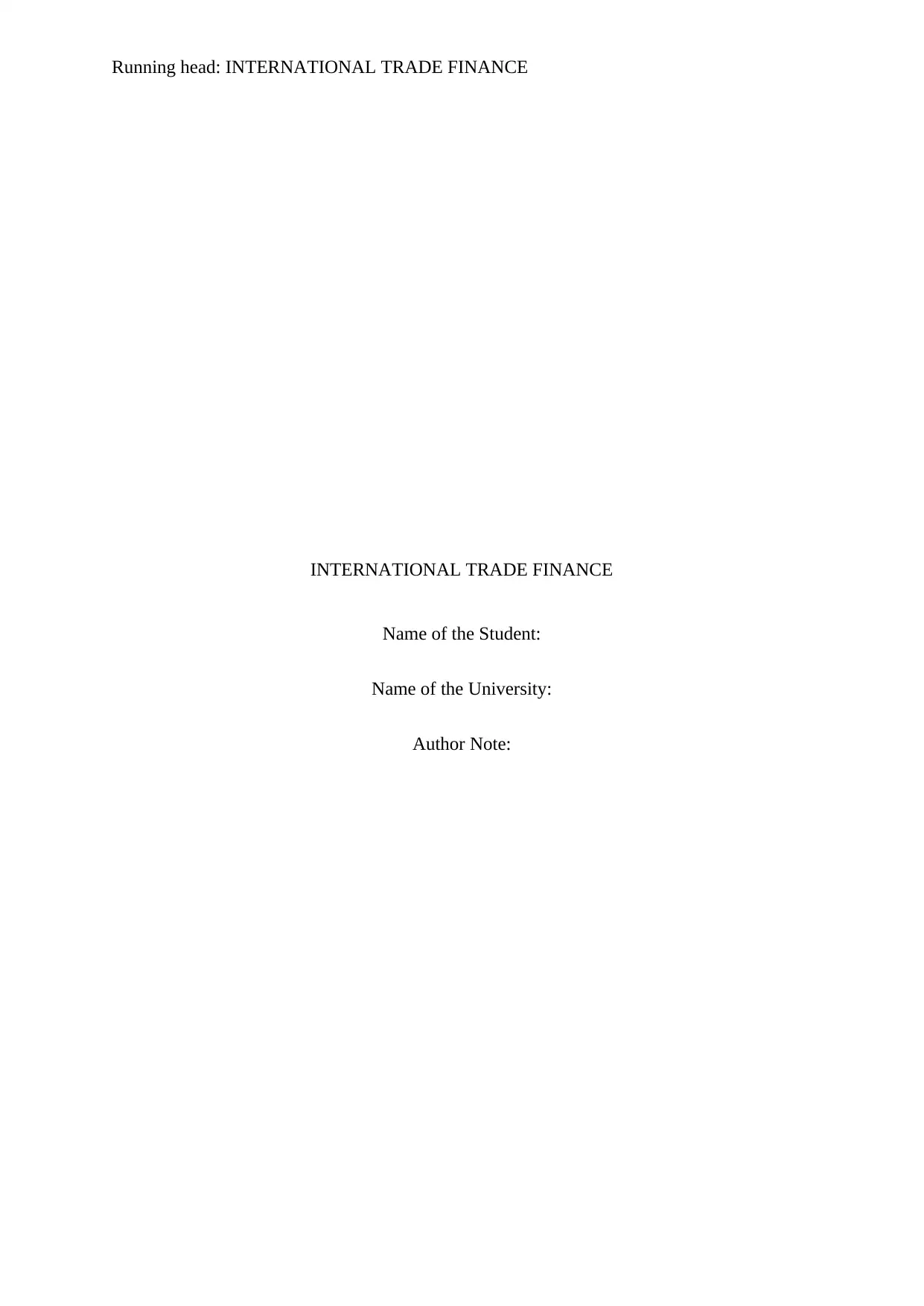
Running head: INTERNATIONAL TRADE FINANCE
INTERNATIONAL TRADE FINANCE
Name of the Student:
Name of the University:
Author Note:
INTERNATIONAL TRADE FINANCE
Name of the Student:
Name of the University:
Author Note:
Paraphrase This Document
Need a fresh take? Get an instant paraphrase of this document with our AI Paraphraser
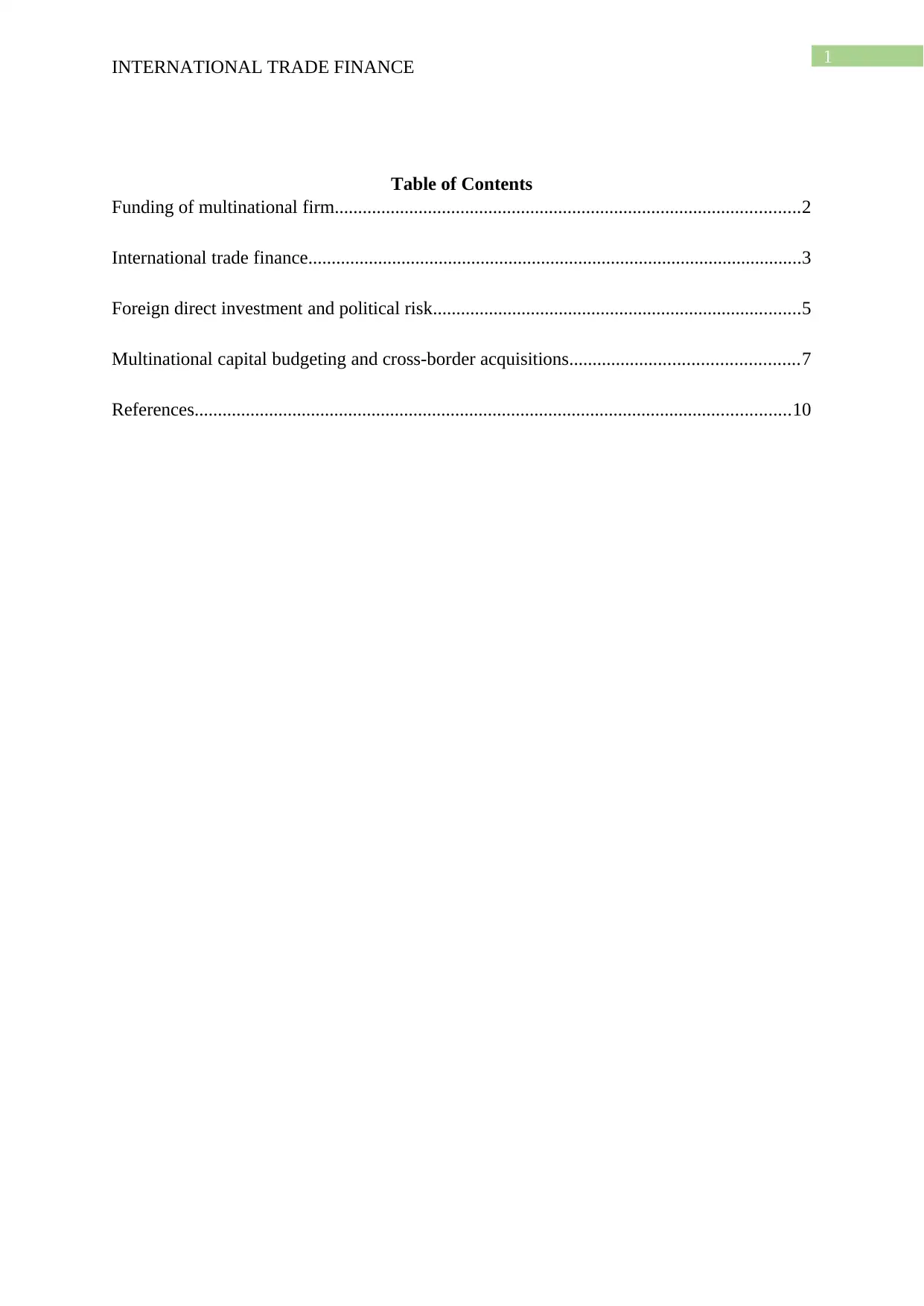
1
INTERNATIONAL TRADE FINANCE
Table of Contents
Funding of multinational firm....................................................................................................2
International trade finance..........................................................................................................3
Foreign direct investment and political risk...............................................................................5
Multinational capital budgeting and cross-border acquisitions.................................................7
References................................................................................................................................10
INTERNATIONAL TRADE FINANCE
Table of Contents
Funding of multinational firm....................................................................................................2
International trade finance..........................................................................................................3
Foreign direct investment and political risk...............................................................................5
Multinational capital budgeting and cross-border acquisitions.................................................7
References................................................................................................................................10
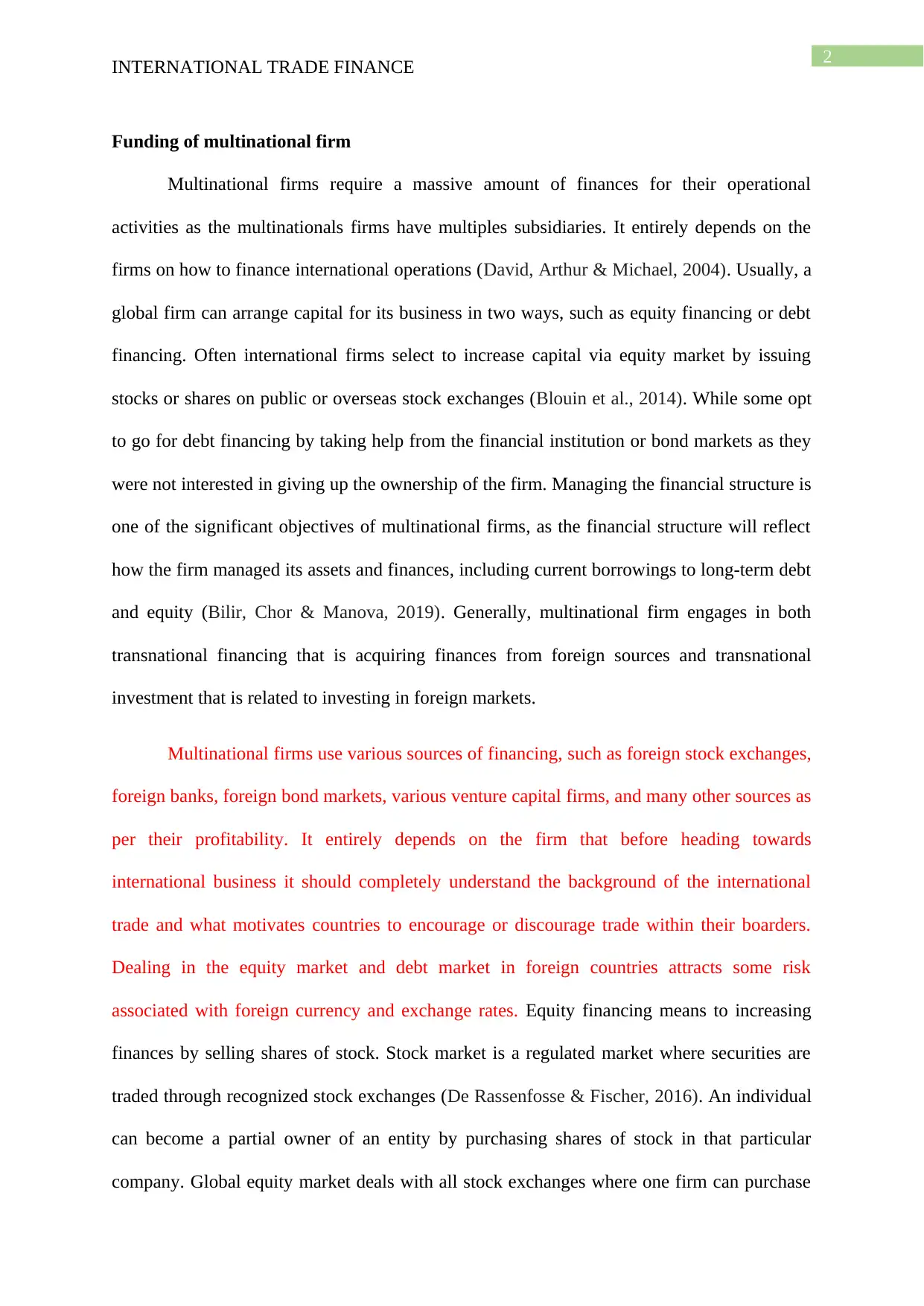
2
INTERNATIONAL TRADE FINANCE
Funding of multinational firm
Multinational firms require a massive amount of finances for their operational
activities as the multinationals firms have multiples subsidiaries. It entirely depends on the
firms on how to finance international operations (David, Arthur & Michael, 2004). Usually, a
global firm can arrange capital for its business in two ways, such as equity financing or debt
financing. Often international firms select to increase capital via equity market by issuing
stocks or shares on public or overseas stock exchanges (Blouin et al., 2014). While some opt
to go for debt financing by taking help from the financial institution or bond markets as they
were not interested in giving up the ownership of the firm. Managing the financial structure is
one of the significant objectives of multinational firms, as the financial structure will reflect
how the firm managed its assets and finances, including current borrowings to long-term debt
and equity (Bilir, Chor & Manova, 2019). Generally, multinational firm engages in both
transnational financing that is acquiring finances from foreign sources and transnational
investment that is related to investing in foreign markets.
Multinational firms use various sources of financing, such as foreign stock exchanges,
foreign banks, foreign bond markets, various venture capital firms, and many other sources as
per their profitability. It entirely depends on the firm that before heading towards
international business it should completely understand the background of the international
trade and what motivates countries to encourage or discourage trade within their boarders.
Dealing in the equity market and debt market in foreign countries attracts some risk
associated with foreign currency and exchange rates. Equity financing means to increasing
finances by selling shares of stock. Stock market is a regulated market where securities are
traded through recognized stock exchanges (De Rassenfosse & Fischer, 2016). An individual
can become a partial owner of an entity by purchasing shares of stock in that particular
company. Global equity market deals with all stock exchanges where one firm can purchase
INTERNATIONAL TRADE FINANCE
Funding of multinational firm
Multinational firms require a massive amount of finances for their operational
activities as the multinationals firms have multiples subsidiaries. It entirely depends on the
firms on how to finance international operations (David, Arthur & Michael, 2004). Usually, a
global firm can arrange capital for its business in two ways, such as equity financing or debt
financing. Often international firms select to increase capital via equity market by issuing
stocks or shares on public or overseas stock exchanges (Blouin et al., 2014). While some opt
to go for debt financing by taking help from the financial institution or bond markets as they
were not interested in giving up the ownership of the firm. Managing the financial structure is
one of the significant objectives of multinational firms, as the financial structure will reflect
how the firm managed its assets and finances, including current borrowings to long-term debt
and equity (Bilir, Chor & Manova, 2019). Generally, multinational firm engages in both
transnational financing that is acquiring finances from foreign sources and transnational
investment that is related to investing in foreign markets.
Multinational firms use various sources of financing, such as foreign stock exchanges,
foreign banks, foreign bond markets, various venture capital firms, and many other sources as
per their profitability. It entirely depends on the firm that before heading towards
international business it should completely understand the background of the international
trade and what motivates countries to encourage or discourage trade within their boarders.
Dealing in the equity market and debt market in foreign countries attracts some risk
associated with foreign currency and exchange rates. Equity financing means to increasing
finances by selling shares of stock. Stock market is a regulated market where securities are
traded through recognized stock exchanges (De Rassenfosse & Fischer, 2016). An individual
can become a partial owner of an entity by purchasing shares of stock in that particular
company. Global equity market deals with all stock exchanges where one firm can purchase
⊘ This is a preview!⊘
Do you want full access?
Subscribe today to unlock all pages.

Trusted by 1+ million students worldwide
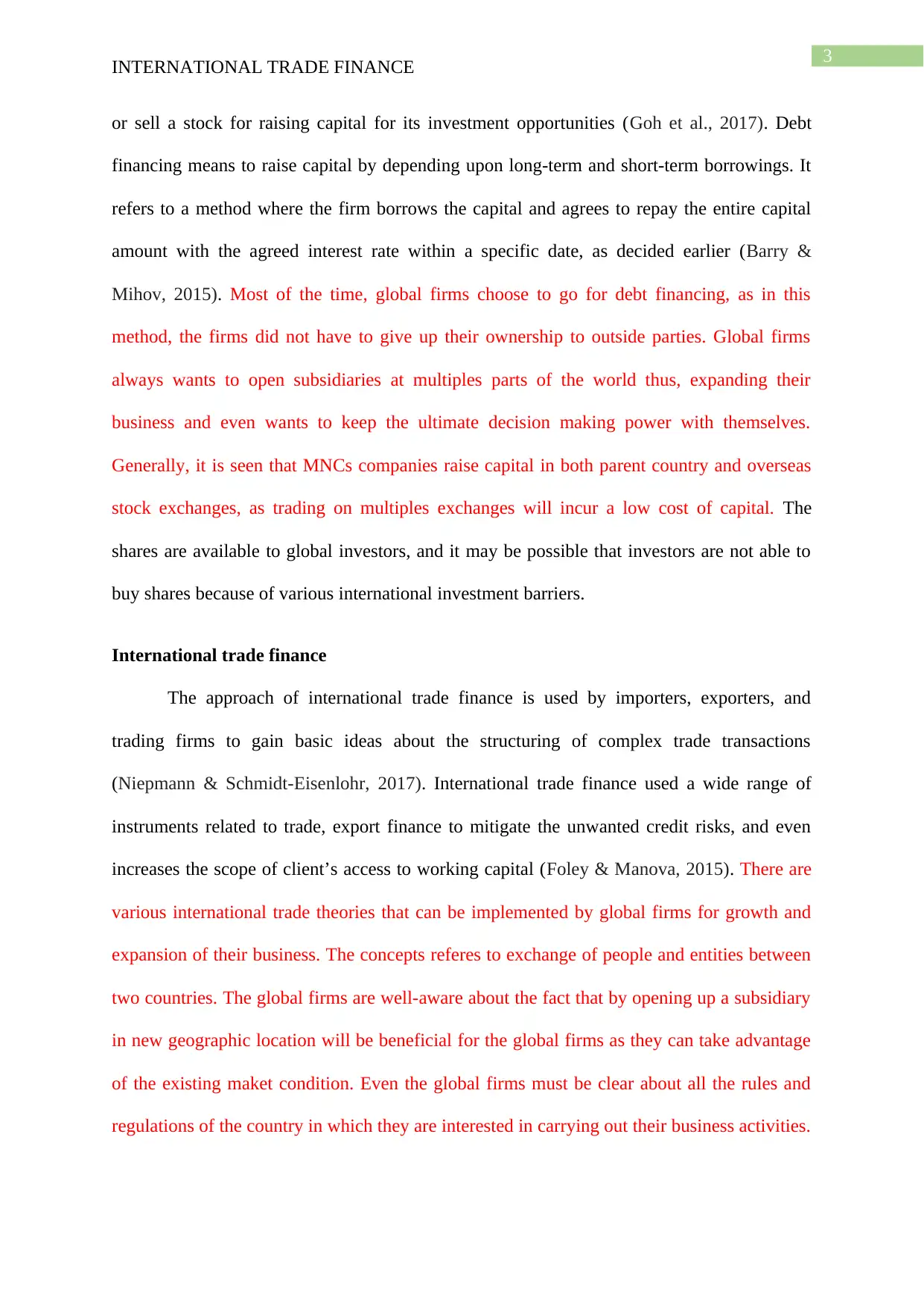
3
INTERNATIONAL TRADE FINANCE
or sell a stock for raising capital for its investment opportunities (Goh et al., 2017). Debt
financing means to raise capital by depending upon long-term and short-term borrowings. It
refers to a method where the firm borrows the capital and agrees to repay the entire capital
amount with the agreed interest rate within a specific date, as decided earlier (Barry &
Mihov, 2015). Most of the time, global firms choose to go for debt financing, as in this
method, the firms did not have to give up their ownership to outside parties. Global firms
always wants to open subsidiaries at multiples parts of the world thus, expanding their
business and even wants to keep the ultimate decision making power with themselves.
Generally, it is seen that MNCs companies raise capital in both parent country and overseas
stock exchanges, as trading on multiples exchanges will incur a low cost of capital. The
shares are available to global investors, and it may be possible that investors are not able to
buy shares because of various international investment barriers.
International trade finance
The approach of international trade finance is used by importers, exporters, and
trading firms to gain basic ideas about the structuring of complex trade transactions
(Niepmann & Schmidt-Eisenlohr, 2017). International trade finance used a wide range of
instruments related to trade, export finance to mitigate the unwanted credit risks, and even
increases the scope of client’s access to working capital (Foley & Manova, 2015). There are
various international trade theories that can be implemented by global firms for growth and
expansion of their business. The concepts referes to exchange of people and entities between
two countries. The global firms are well-aware about the fact that by opening up a subsidiary
in new geographic location will be beneficial for the global firms as they can take advantage
of the existing maket condition. Even the global firms must be clear about all the rules and
regulations of the country in which they are interested in carrying out their business activities.
INTERNATIONAL TRADE FINANCE
or sell a stock for raising capital for its investment opportunities (Goh et al., 2017). Debt
financing means to raise capital by depending upon long-term and short-term borrowings. It
refers to a method where the firm borrows the capital and agrees to repay the entire capital
amount with the agreed interest rate within a specific date, as decided earlier (Barry &
Mihov, 2015). Most of the time, global firms choose to go for debt financing, as in this
method, the firms did not have to give up their ownership to outside parties. Global firms
always wants to open subsidiaries at multiples parts of the world thus, expanding their
business and even wants to keep the ultimate decision making power with themselves.
Generally, it is seen that MNCs companies raise capital in both parent country and overseas
stock exchanges, as trading on multiples exchanges will incur a low cost of capital. The
shares are available to global investors, and it may be possible that investors are not able to
buy shares because of various international investment barriers.
International trade finance
The approach of international trade finance is used by importers, exporters, and
trading firms to gain basic ideas about the structuring of complex trade transactions
(Niepmann & Schmidt-Eisenlohr, 2017). International trade finance used a wide range of
instruments related to trade, export finance to mitigate the unwanted credit risks, and even
increases the scope of client’s access to working capital (Foley & Manova, 2015). There are
various international trade theories that can be implemented by global firms for growth and
expansion of their business. The concepts referes to exchange of people and entities between
two countries. The global firms are well-aware about the fact that by opening up a subsidiary
in new geographic location will be beneficial for the global firms as they can take advantage
of the existing maket condition. Even the global firms must be clear about all the rules and
regulations of the country in which they are interested in carrying out their business activities.
Paraphrase This Document
Need a fresh take? Get an instant paraphrase of this document with our AI Paraphraser
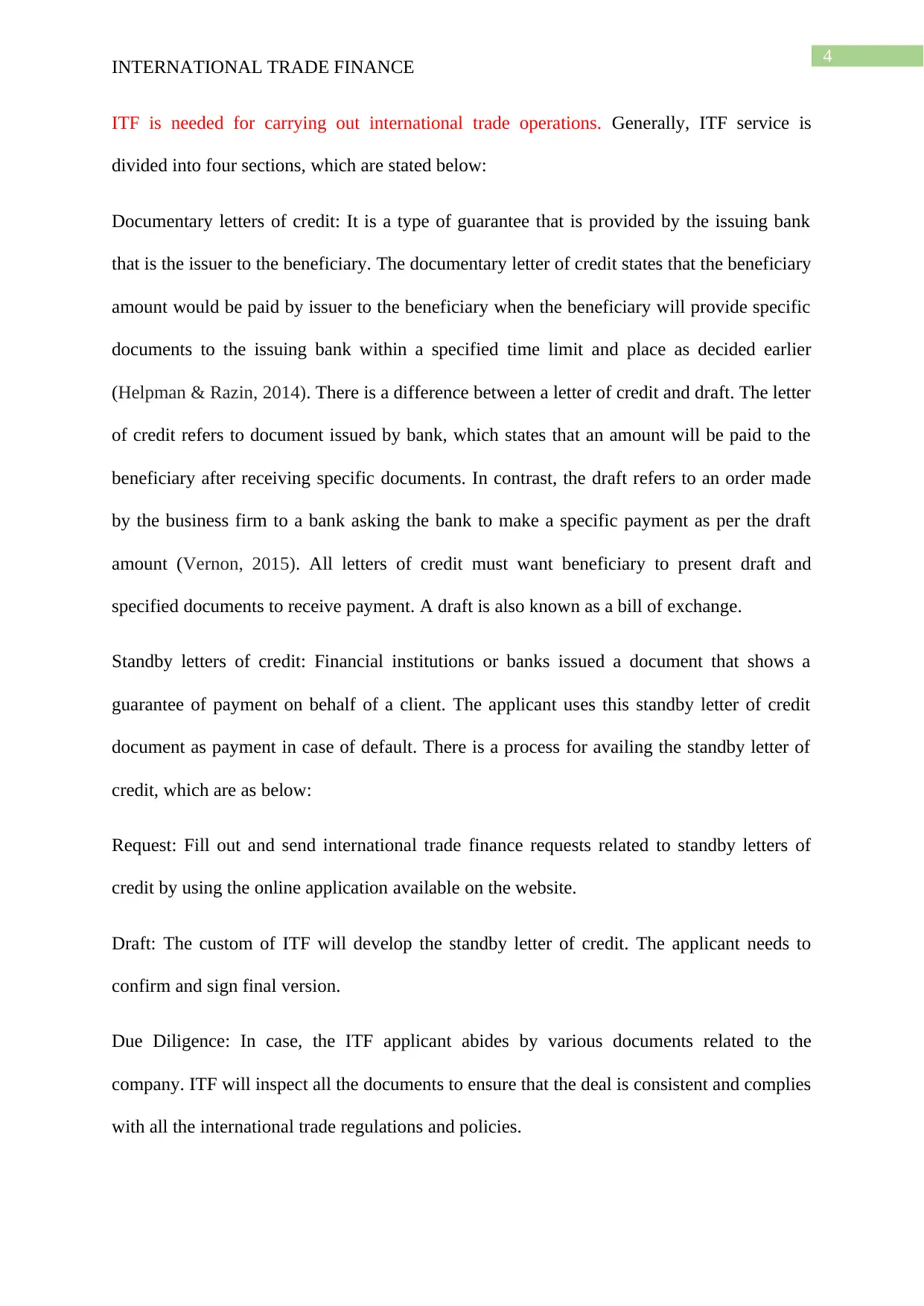
4
INTERNATIONAL TRADE FINANCE
ITF is needed for carrying out international trade operations. Generally, ITF service is
divided into four sections, which are stated below:
Documentary letters of credit: It is a type of guarantee that is provided by the issuing bank
that is the issuer to the beneficiary. The documentary letter of credit states that the beneficiary
amount would be paid by issuer to the beneficiary when the beneficiary will provide specific
documents to the issuing bank within a specified time limit and place as decided earlier
(Helpman & Razin, 2014). There is a difference between a letter of credit and draft. The letter
of credit refers to document issued by bank, which states that an amount will be paid to the
beneficiary after receiving specific documents. In contrast, the draft refers to an order made
by the business firm to a bank asking the bank to make a specific payment as per the draft
amount (Vernon, 2015). All letters of credit must want beneficiary to present draft and
specified documents to receive payment. A draft is also known as a bill of exchange.
Standby letters of credit: Financial institutions or banks issued a document that shows a
guarantee of payment on behalf of a client. The applicant uses this standby letter of credit
document as payment in case of default. There is a process for availing the standby letter of
credit, which are as below:
Request: Fill out and send international trade finance requests related to standby letters of
credit by using the online application available on the website.
Draft: The custom of ITF will develop the standby letter of credit. The applicant needs to
confirm and sign final version.
Due Diligence: In case, the ITF applicant abides by various documents related to the
company. ITF will inspect all the documents to ensure that the deal is consistent and complies
with all the international trade regulations and policies.
INTERNATIONAL TRADE FINANCE
ITF is needed for carrying out international trade operations. Generally, ITF service is
divided into four sections, which are stated below:
Documentary letters of credit: It is a type of guarantee that is provided by the issuing bank
that is the issuer to the beneficiary. The documentary letter of credit states that the beneficiary
amount would be paid by issuer to the beneficiary when the beneficiary will provide specific
documents to the issuing bank within a specified time limit and place as decided earlier
(Helpman & Razin, 2014). There is a difference between a letter of credit and draft. The letter
of credit refers to document issued by bank, which states that an amount will be paid to the
beneficiary after receiving specific documents. In contrast, the draft refers to an order made
by the business firm to a bank asking the bank to make a specific payment as per the draft
amount (Vernon, 2015). All letters of credit must want beneficiary to present draft and
specified documents to receive payment. A draft is also known as a bill of exchange.
Standby letters of credit: Financial institutions or banks issued a document that shows a
guarantee of payment on behalf of a client. The applicant uses this standby letter of credit
document as payment in case of default. There is a process for availing the standby letter of
credit, which are as below:
Request: Fill out and send international trade finance requests related to standby letters of
credit by using the online application available on the website.
Draft: The custom of ITF will develop the standby letter of credit. The applicant needs to
confirm and sign final version.
Due Diligence: In case, the ITF applicant abides by various documents related to the
company. ITF will inspect all the documents to ensure that the deal is consistent and complies
with all the international trade regulations and policies.
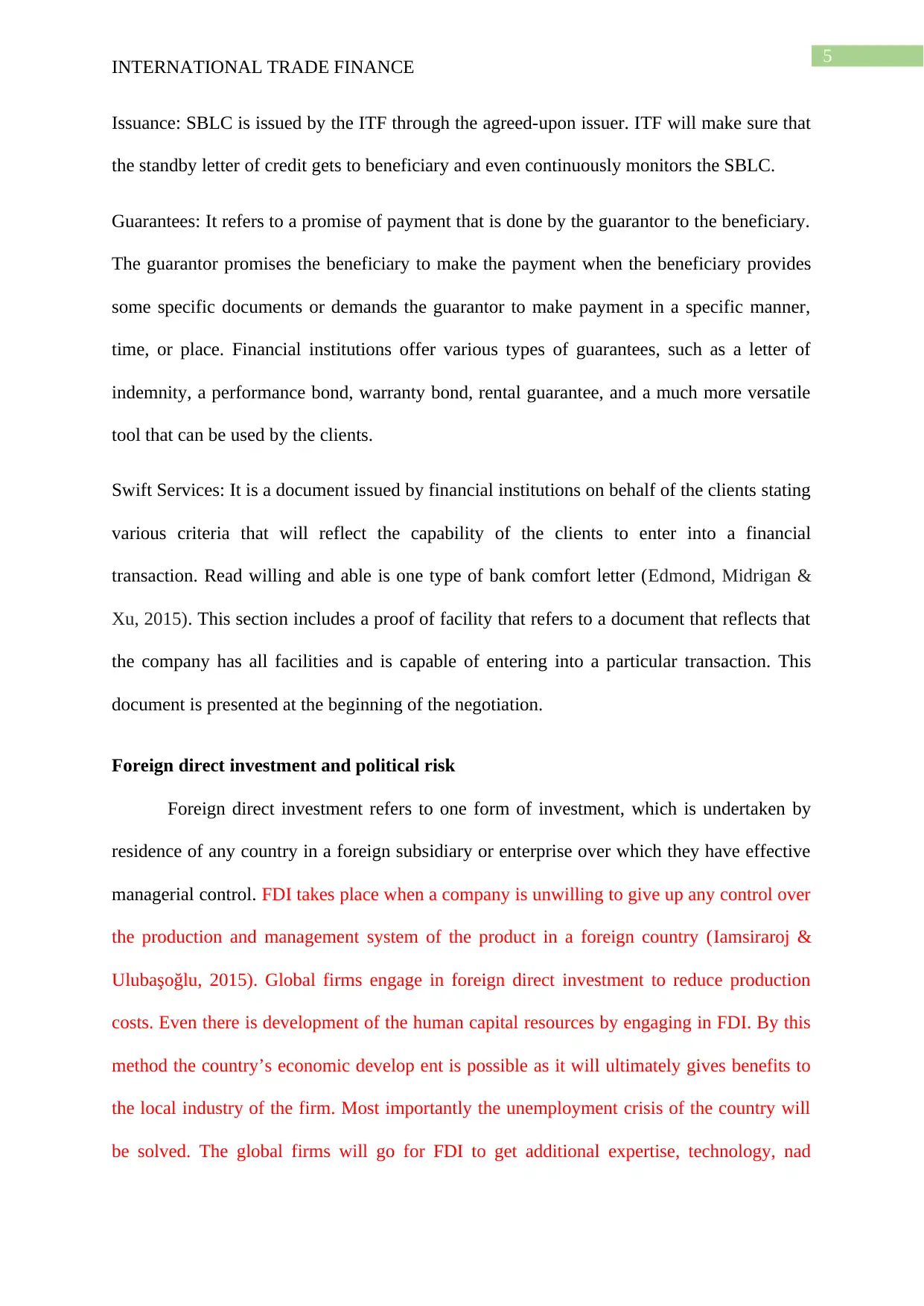
5
INTERNATIONAL TRADE FINANCE
Issuance: SBLC is issued by the ITF through the agreed-upon issuer. ITF will make sure that
the standby letter of credit gets to beneficiary and even continuously monitors the SBLC.
Guarantees: It refers to a promise of payment that is done by the guarantor to the beneficiary.
The guarantor promises the beneficiary to make the payment when the beneficiary provides
some specific documents or demands the guarantor to make payment in a specific manner,
time, or place. Financial institutions offer various types of guarantees, such as a letter of
indemnity, a performance bond, warranty bond, rental guarantee, and a much more versatile
tool that can be used by the clients.
Swift Services: It is a document issued by financial institutions on behalf of the clients stating
various criteria that will reflect the capability of the clients to enter into a financial
transaction. Read willing and able is one type of bank comfort letter (Edmond, Midrigan &
Xu, 2015). This section includes a proof of facility that refers to a document that reflects that
the company has all facilities and is capable of entering into a particular transaction. This
document is presented at the beginning of the negotiation.
Foreign direct investment and political risk
Foreign direct investment refers to one form of investment, which is undertaken by
residence of any country in a foreign subsidiary or enterprise over which they have effective
managerial control. FDI takes place when a company is unwilling to give up any control over
the production and management system of the product in a foreign country (Iamsiraroj &
Ulubaşoğlu, 2015). Global firms engage in foreign direct investment to reduce production
costs. Even there is development of the human capital resources by engaging in FDI. By this
method the country’s economic develop ent is possible as it will ultimately gives benefits to
the local industry of the firm. Most importantly the unemployment crisis of the country will
be solved. The global firms will go for FDI to get additional expertise, technology, nad
INTERNATIONAL TRADE FINANCE
Issuance: SBLC is issued by the ITF through the agreed-upon issuer. ITF will make sure that
the standby letter of credit gets to beneficiary and even continuously monitors the SBLC.
Guarantees: It refers to a promise of payment that is done by the guarantor to the beneficiary.
The guarantor promises the beneficiary to make the payment when the beneficiary provides
some specific documents or demands the guarantor to make payment in a specific manner,
time, or place. Financial institutions offer various types of guarantees, such as a letter of
indemnity, a performance bond, warranty bond, rental guarantee, and a much more versatile
tool that can be used by the clients.
Swift Services: It is a document issued by financial institutions on behalf of the clients stating
various criteria that will reflect the capability of the clients to enter into a financial
transaction. Read willing and able is one type of bank comfort letter (Edmond, Midrigan &
Xu, 2015). This section includes a proof of facility that refers to a document that reflects that
the company has all facilities and is capable of entering into a particular transaction. This
document is presented at the beginning of the negotiation.
Foreign direct investment and political risk
Foreign direct investment refers to one form of investment, which is undertaken by
residence of any country in a foreign subsidiary or enterprise over which they have effective
managerial control. FDI takes place when a company is unwilling to give up any control over
the production and management system of the product in a foreign country (Iamsiraroj &
Ulubaşoğlu, 2015). Global firms engage in foreign direct investment to reduce production
costs. Even there is development of the human capital resources by engaging in FDI. By this
method the country’s economic develop ent is possible as it will ultimately gives benefits to
the local industry of the firm. Most importantly the unemployment crisis of the country will
be solved. The global firms will go for FDI to get additional expertise, technology, nad
⊘ This is a preview!⊘
Do you want full access?
Subscribe today to unlock all pages.

Trusted by 1+ million students worldwide
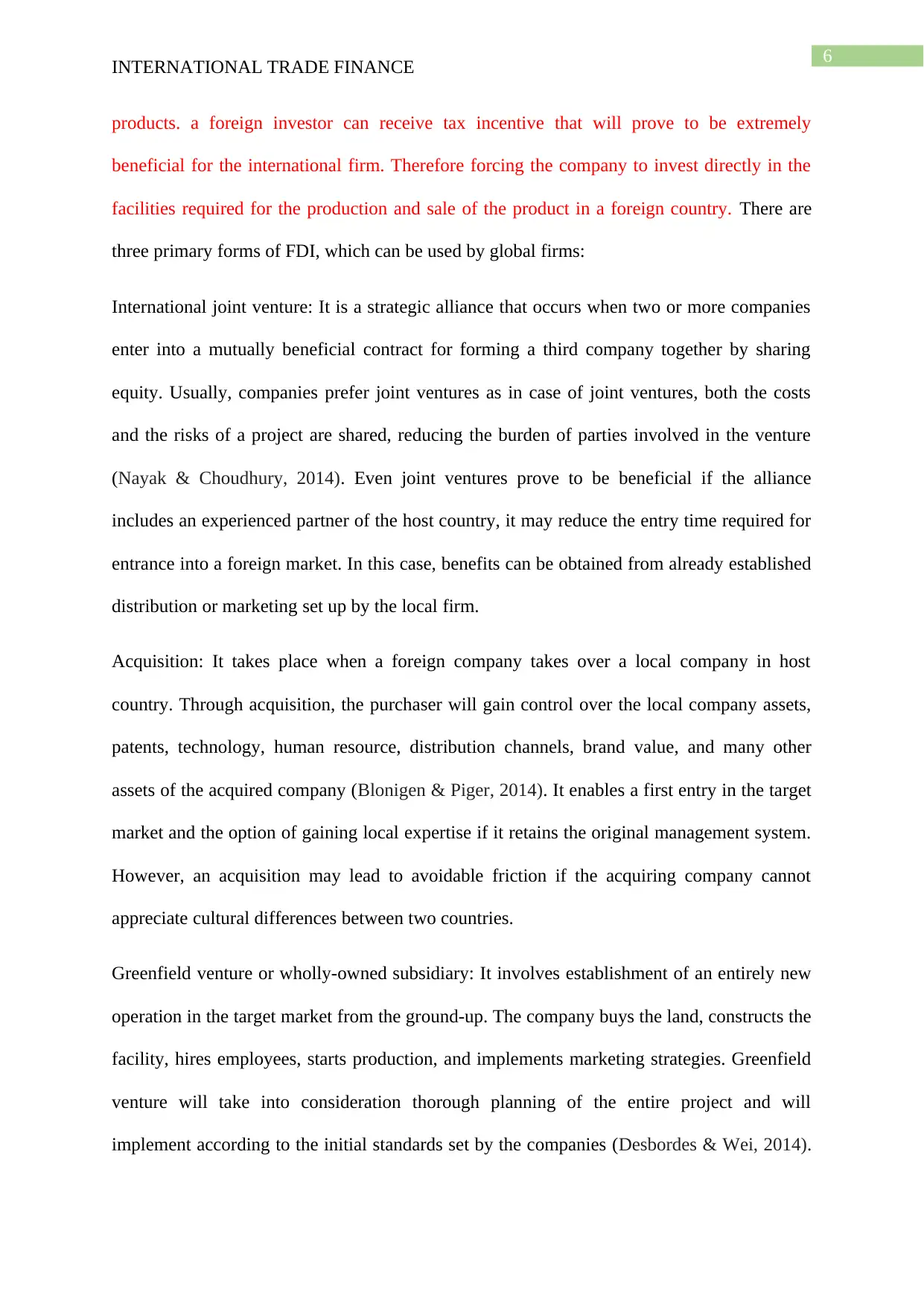
6
INTERNATIONAL TRADE FINANCE
products. a foreign investor can receive tax incentive that will prove to be extremely
beneficial for the international firm. Therefore forcing the company to invest directly in the
facilities required for the production and sale of the product in a foreign country. There are
three primary forms of FDI, which can be used by global firms:
International joint venture: It is a strategic alliance that occurs when two or more companies
enter into a mutually beneficial contract for forming a third company together by sharing
equity. Usually, companies prefer joint ventures as in case of joint ventures, both the costs
and the risks of a project are shared, reducing the burden of parties involved in the venture
(Nayak & Choudhury, 2014). Even joint ventures prove to be beneficial if the alliance
includes an experienced partner of the host country, it may reduce the entry time required for
entrance into a foreign market. In this case, benefits can be obtained from already established
distribution or marketing set up by the local firm.
Acquisition: It takes place when a foreign company takes over a local company in host
country. Through acquisition, the purchaser will gain control over the local company assets,
patents, technology, human resource, distribution channels, brand value, and many other
assets of the acquired company (Blonigen & Piger, 2014). It enables a first entry in the target
market and the option of gaining local expertise if it retains the original management system.
However, an acquisition may lead to avoidable friction if the acquiring company cannot
appreciate cultural differences between two countries.
Greenfield venture or wholly-owned subsidiary: It involves establishment of an entirely new
operation in the target market from the ground-up. The company buys the land, constructs the
facility, hires employees, starts production, and implements marketing strategies. Greenfield
venture will take into consideration thorough planning of the entire project and will
implement according to the initial standards set by the companies (Desbordes & Wei, 2014).
INTERNATIONAL TRADE FINANCE
products. a foreign investor can receive tax incentive that will prove to be extremely
beneficial for the international firm. Therefore forcing the company to invest directly in the
facilities required for the production and sale of the product in a foreign country. There are
three primary forms of FDI, which can be used by global firms:
International joint venture: It is a strategic alliance that occurs when two or more companies
enter into a mutually beneficial contract for forming a third company together by sharing
equity. Usually, companies prefer joint ventures as in case of joint ventures, both the costs
and the risks of a project are shared, reducing the burden of parties involved in the venture
(Nayak & Choudhury, 2014). Even joint ventures prove to be beneficial if the alliance
includes an experienced partner of the host country, it may reduce the entry time required for
entrance into a foreign market. In this case, benefits can be obtained from already established
distribution or marketing set up by the local firm.
Acquisition: It takes place when a foreign company takes over a local company in host
country. Through acquisition, the purchaser will gain control over the local company assets,
patents, technology, human resource, distribution channels, brand value, and many other
assets of the acquired company (Blonigen & Piger, 2014). It enables a first entry in the target
market and the option of gaining local expertise if it retains the original management system.
However, an acquisition may lead to avoidable friction if the acquiring company cannot
appreciate cultural differences between two countries.
Greenfield venture or wholly-owned subsidiary: It involves establishment of an entirely new
operation in the target market from the ground-up. The company buys the land, constructs the
facility, hires employees, starts production, and implements marketing strategies. Greenfield
venture will take into consideration thorough planning of the entire project and will
implement according to the initial standards set by the companies (Desbordes & Wei, 2014).
Paraphrase This Document
Need a fresh take? Get an instant paraphrase of this document with our AI Paraphraser
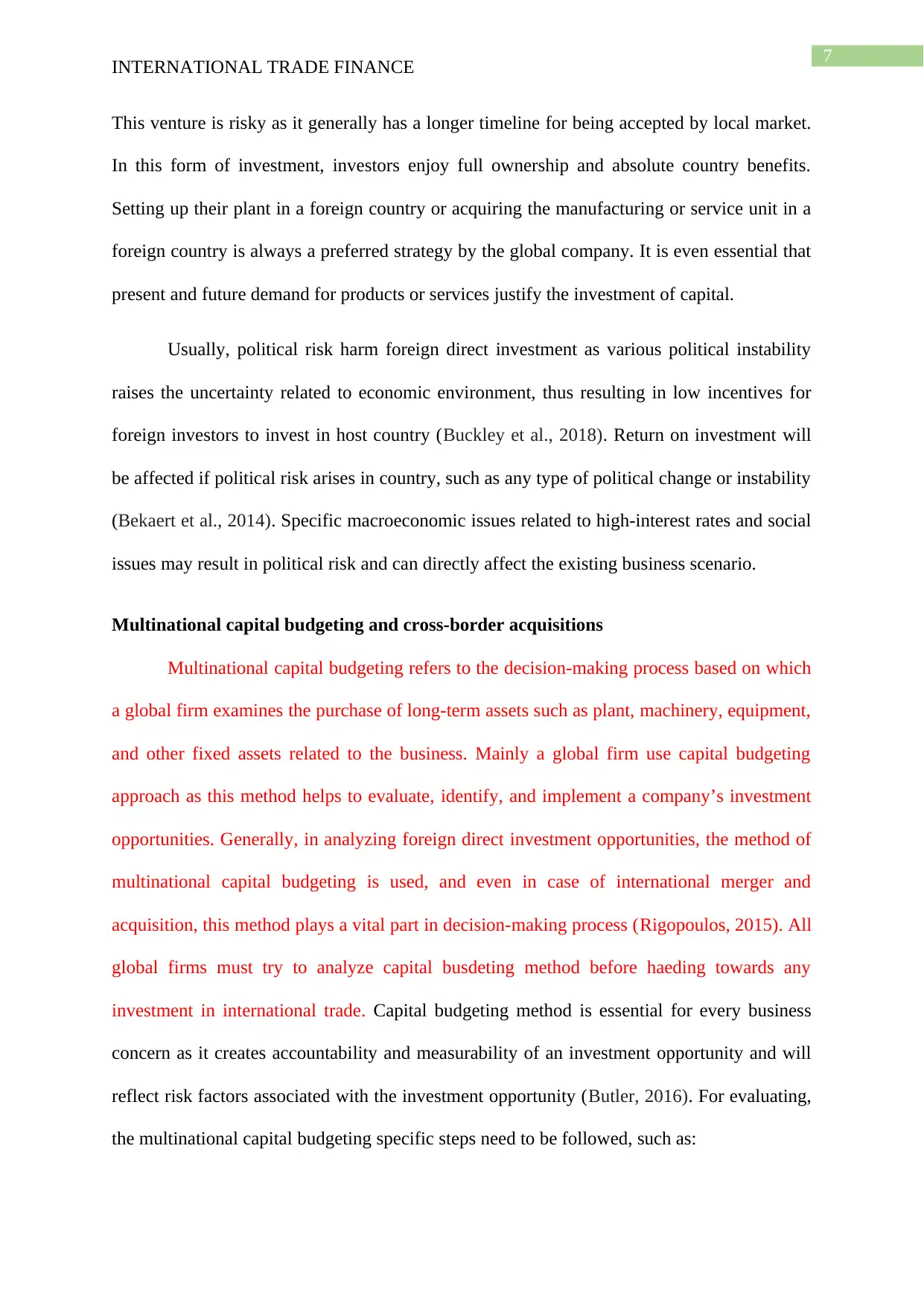
7
INTERNATIONAL TRADE FINANCE
This venture is risky as it generally has a longer timeline for being accepted by local market.
In this form of investment, investors enjoy full ownership and absolute country benefits.
Setting up their plant in a foreign country or acquiring the manufacturing or service unit in a
foreign country is always a preferred strategy by the global company. It is even essential that
present and future demand for products or services justify the investment of capital.
Usually, political risk harm foreign direct investment as various political instability
raises the uncertainty related to economic environment, thus resulting in low incentives for
foreign investors to invest in host country (Buckley et al., 2018). Return on investment will
be affected if political risk arises in country, such as any type of political change or instability
(Bekaert et al., 2014). Specific macroeconomic issues related to high-interest rates and social
issues may result in political risk and can directly affect the existing business scenario.
Multinational capital budgeting and cross-border acquisitions
Multinational capital budgeting refers to the decision-making process based on which
a global firm examines the purchase of long-term assets such as plant, machinery, equipment,
and other fixed assets related to the business. Mainly a global firm use capital budgeting
approach as this method helps to evaluate, identify, and implement a company’s investment
opportunities. Generally, in analyzing foreign direct investment opportunities, the method of
multinational capital budgeting is used, and even in case of international merger and
acquisition, this method plays a vital part in decision-making process (Rigopoulos, 2015). All
global firms must try to analyze capital busdeting method before haeding towards any
investment in international trade. Capital budgeting method is essential for every business
concern as it creates accountability and measurability of an investment opportunity and will
reflect risk factors associated with the investment opportunity (Butler, 2016). For evaluating,
the multinational capital budgeting specific steps need to be followed, such as:
INTERNATIONAL TRADE FINANCE
This venture is risky as it generally has a longer timeline for being accepted by local market.
In this form of investment, investors enjoy full ownership and absolute country benefits.
Setting up their plant in a foreign country or acquiring the manufacturing or service unit in a
foreign country is always a preferred strategy by the global company. It is even essential that
present and future demand for products or services justify the investment of capital.
Usually, political risk harm foreign direct investment as various political instability
raises the uncertainty related to economic environment, thus resulting in low incentives for
foreign investors to invest in host country (Buckley et al., 2018). Return on investment will
be affected if political risk arises in country, such as any type of political change or instability
(Bekaert et al., 2014). Specific macroeconomic issues related to high-interest rates and social
issues may result in political risk and can directly affect the existing business scenario.
Multinational capital budgeting and cross-border acquisitions
Multinational capital budgeting refers to the decision-making process based on which
a global firm examines the purchase of long-term assets such as plant, machinery, equipment,
and other fixed assets related to the business. Mainly a global firm use capital budgeting
approach as this method helps to evaluate, identify, and implement a company’s investment
opportunities. Generally, in analyzing foreign direct investment opportunities, the method of
multinational capital budgeting is used, and even in case of international merger and
acquisition, this method plays a vital part in decision-making process (Rigopoulos, 2015). All
global firms must try to analyze capital busdeting method before haeding towards any
investment in international trade. Capital budgeting method is essential for every business
concern as it creates accountability and measurability of an investment opportunity and will
reflect risk factors associated with the investment opportunity (Butler, 2016). For evaluating,
the multinational capital budgeting specific steps need to be followed, such as:
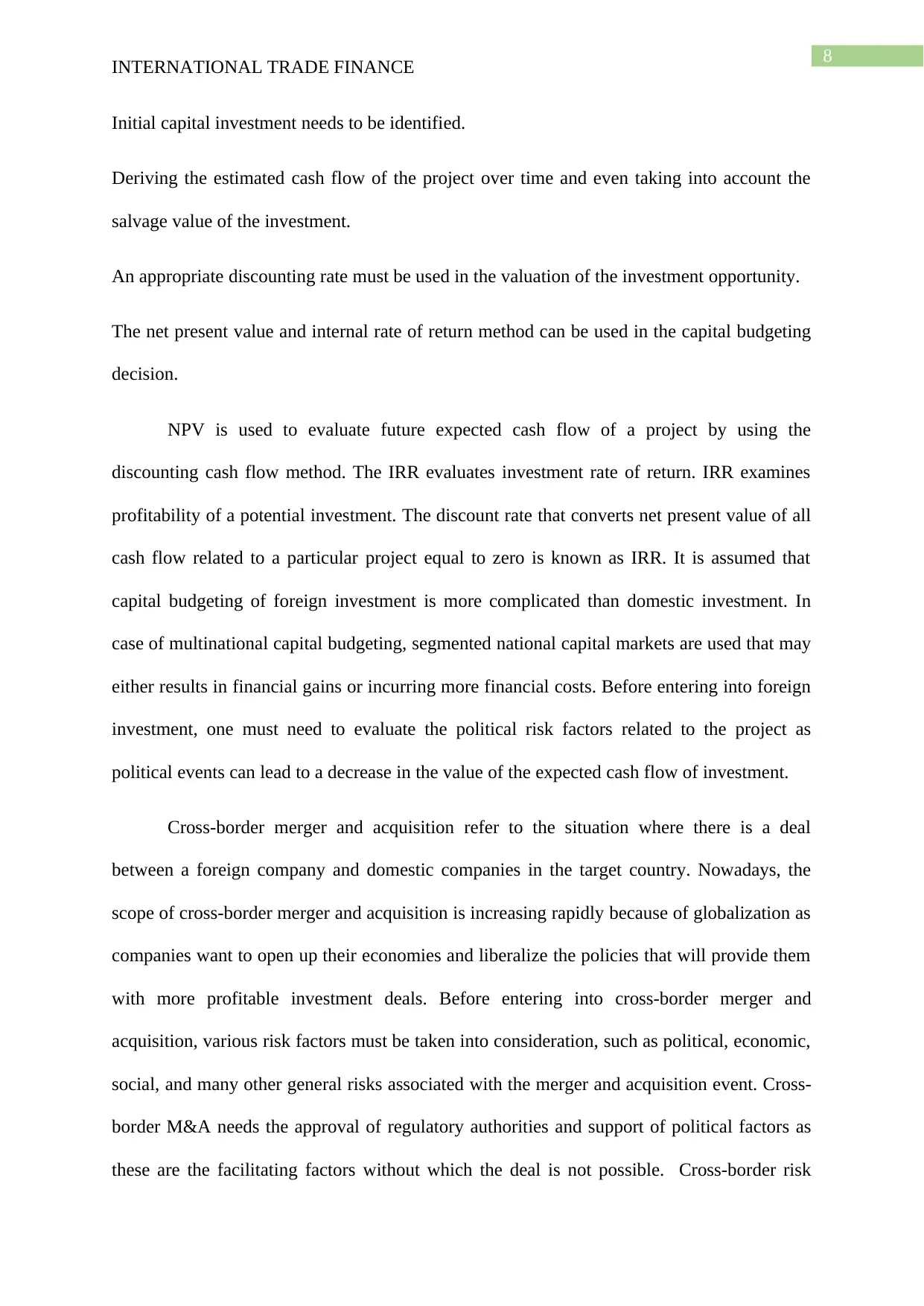
8
INTERNATIONAL TRADE FINANCE
Initial capital investment needs to be identified.
Deriving the estimated cash flow of the project over time and even taking into account the
salvage value of the investment.
An appropriate discounting rate must be used in the valuation of the investment opportunity.
The net present value and internal rate of return method can be used in the capital budgeting
decision.
NPV is used to evaluate future expected cash flow of a project by using the
discounting cash flow method. The IRR evaluates investment rate of return. IRR examines
profitability of a potential investment. The discount rate that converts net present value of all
cash flow related to a particular project equal to zero is known as IRR. It is assumed that
capital budgeting of foreign investment is more complicated than domestic investment. In
case of multinational capital budgeting, segmented national capital markets are used that may
either results in financial gains or incurring more financial costs. Before entering into foreign
investment, one must need to evaluate the political risk factors related to the project as
political events can lead to a decrease in the value of the expected cash flow of investment.
Cross-border merger and acquisition refer to the situation where there is a deal
between a foreign company and domestic companies in the target country. Nowadays, the
scope of cross-border merger and acquisition is increasing rapidly because of globalization as
companies want to open up their economies and liberalize the policies that will provide them
with more profitable investment deals. Before entering into cross-border merger and
acquisition, various risk factors must be taken into consideration, such as political, economic,
social, and many other general risks associated with the merger and acquisition event. Cross-
border M&A needs the approval of regulatory authorities and support of political factors as
these are the facilitating factors without which the deal is not possible. Cross-border risk
INTERNATIONAL TRADE FINANCE
Initial capital investment needs to be identified.
Deriving the estimated cash flow of the project over time and even taking into account the
salvage value of the investment.
An appropriate discounting rate must be used in the valuation of the investment opportunity.
The net present value and internal rate of return method can be used in the capital budgeting
decision.
NPV is used to evaluate future expected cash flow of a project by using the
discounting cash flow method. The IRR evaluates investment rate of return. IRR examines
profitability of a potential investment. The discount rate that converts net present value of all
cash flow related to a particular project equal to zero is known as IRR. It is assumed that
capital budgeting of foreign investment is more complicated than domestic investment. In
case of multinational capital budgeting, segmented national capital markets are used that may
either results in financial gains or incurring more financial costs. Before entering into foreign
investment, one must need to evaluate the political risk factors related to the project as
political events can lead to a decrease in the value of the expected cash flow of investment.
Cross-border merger and acquisition refer to the situation where there is a deal
between a foreign company and domestic companies in the target country. Nowadays, the
scope of cross-border merger and acquisition is increasing rapidly because of globalization as
companies want to open up their economies and liberalize the policies that will provide them
with more profitable investment deals. Before entering into cross-border merger and
acquisition, various risk factors must be taken into consideration, such as political, economic,
social, and many other general risks associated with the merger and acquisition event. Cross-
border M&A needs the approval of regulatory authorities and support of political factors as
these are the facilitating factors without which the deal is not possible. Cross-border risk
⊘ This is a preview!⊘
Do you want full access?
Subscribe today to unlock all pages.

Trusted by 1+ million students worldwide
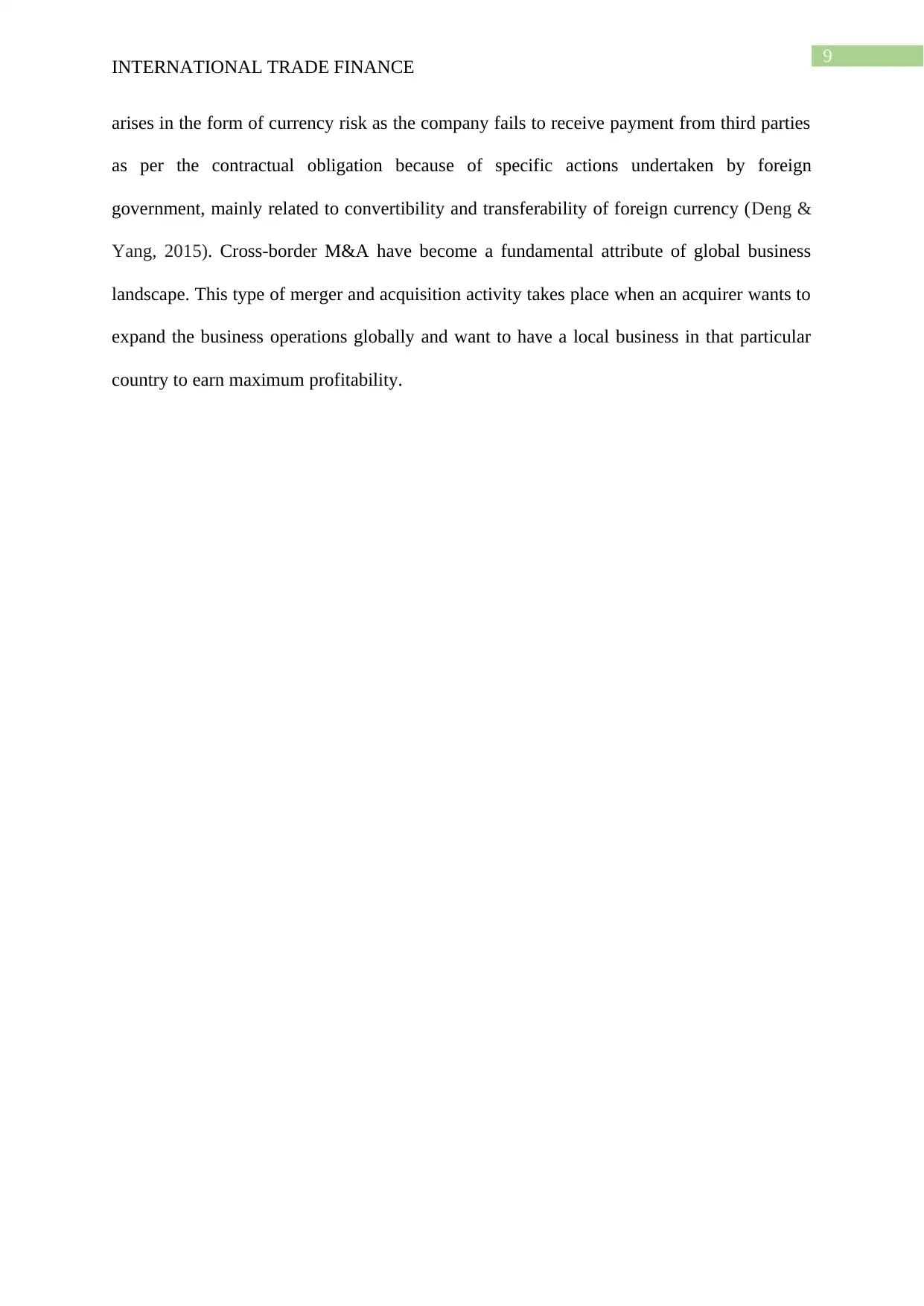
9
INTERNATIONAL TRADE FINANCE
arises in the form of currency risk as the company fails to receive payment from third parties
as per the contractual obligation because of specific actions undertaken by foreign
government, mainly related to convertibility and transferability of foreign currency (Deng &
Yang, 2015). Cross-border M&A have become a fundamental attribute of global business
landscape. This type of merger and acquisition activity takes place when an acquirer wants to
expand the business operations globally and want to have a local business in that particular
country to earn maximum profitability.
INTERNATIONAL TRADE FINANCE
arises in the form of currency risk as the company fails to receive payment from third parties
as per the contractual obligation because of specific actions undertaken by foreign
government, mainly related to convertibility and transferability of foreign currency (Deng &
Yang, 2015). Cross-border M&A have become a fundamental attribute of global business
landscape. This type of merger and acquisition activity takes place when an acquirer wants to
expand the business operations globally and want to have a local business in that particular
country to earn maximum profitability.
Paraphrase This Document
Need a fresh take? Get an instant paraphrase of this document with our AI Paraphraser
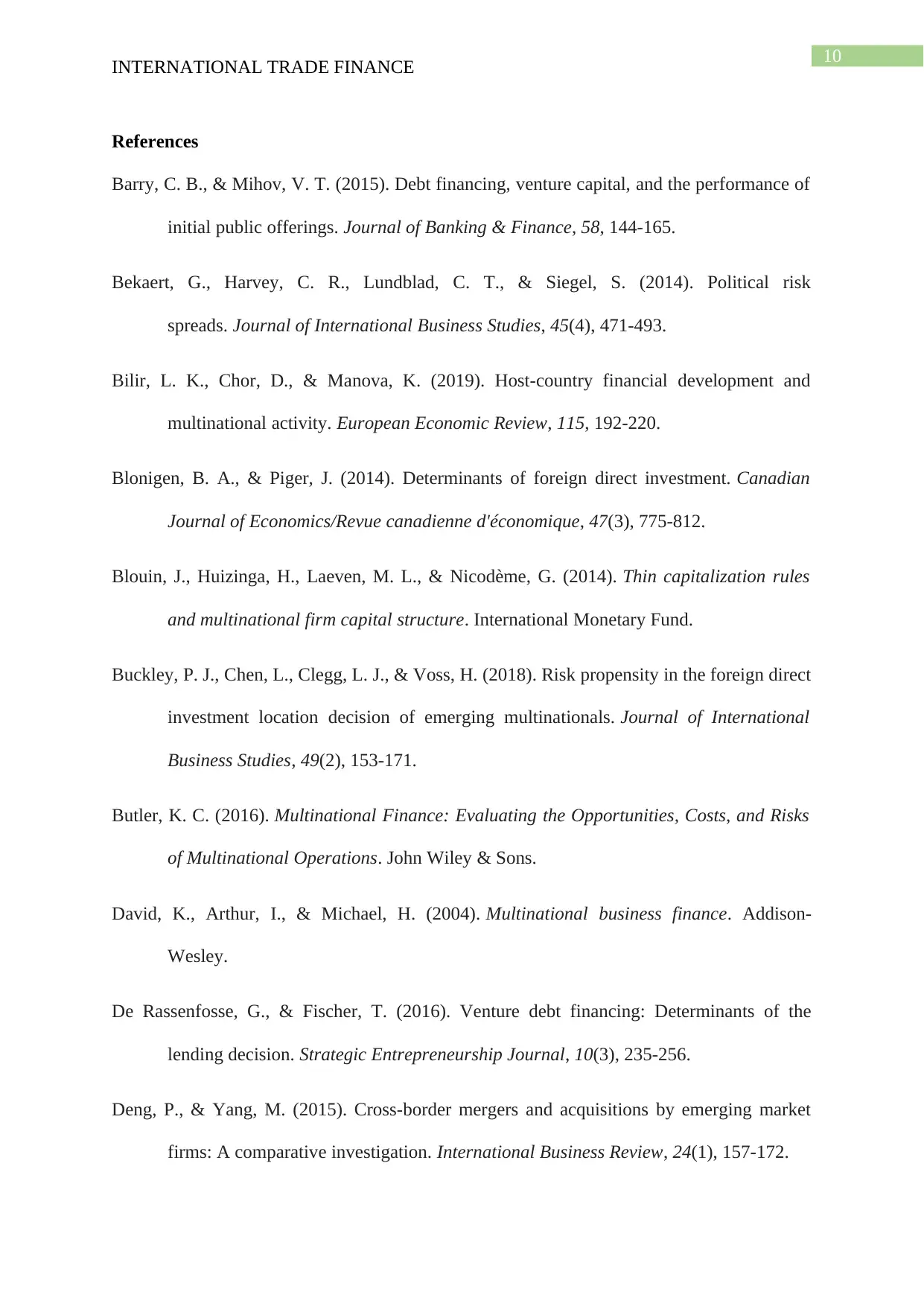
10
INTERNATIONAL TRADE FINANCE
References
Barry, C. B., & Mihov, V. T. (2015). Debt financing, venture capital, and the performance of
initial public offerings. Journal of Banking & Finance, 58, 144-165.
Bekaert, G., Harvey, C. R., Lundblad, C. T., & Siegel, S. (2014). Political risk
spreads. Journal of International Business Studies, 45(4), 471-493.
Bilir, L. K., Chor, D., & Manova, K. (2019). Host-country financial development and
multinational activity. European Economic Review, 115, 192-220.
Blonigen, B. A., & Piger, J. (2014). Determinants of foreign direct investment. Canadian
Journal of Economics/Revue canadienne d'économique, 47(3), 775-812.
Blouin, J., Huizinga, H., Laeven, M. L., & Nicodème, G. (2014). Thin capitalization rules
and multinational firm capital structure. International Monetary Fund.
Buckley, P. J., Chen, L., Clegg, L. J., & Voss, H. (2018). Risk propensity in the foreign direct
investment location decision of emerging multinationals. Journal of International
Business Studies, 49(2), 153-171.
Butler, K. C. (2016). Multinational Finance: Evaluating the Opportunities, Costs, and Risks
of Multinational Operations. John Wiley & Sons.
David, K., Arthur, I., & Michael, H. (2004). Multinational business finance. Addison-
Wesley.
De Rassenfosse, G., & Fischer, T. (2016). Venture debt financing: Determinants of the
lending decision. Strategic Entrepreneurship Journal, 10(3), 235-256.
Deng, P., & Yang, M. (2015). Cross-border mergers and acquisitions by emerging market
firms: A comparative investigation. International Business Review, 24(1), 157-172.
INTERNATIONAL TRADE FINANCE
References
Barry, C. B., & Mihov, V. T. (2015). Debt financing, venture capital, and the performance of
initial public offerings. Journal of Banking & Finance, 58, 144-165.
Bekaert, G., Harvey, C. R., Lundblad, C. T., & Siegel, S. (2014). Political risk
spreads. Journal of International Business Studies, 45(4), 471-493.
Bilir, L. K., Chor, D., & Manova, K. (2019). Host-country financial development and
multinational activity. European Economic Review, 115, 192-220.
Blonigen, B. A., & Piger, J. (2014). Determinants of foreign direct investment. Canadian
Journal of Economics/Revue canadienne d'économique, 47(3), 775-812.
Blouin, J., Huizinga, H., Laeven, M. L., & Nicodème, G. (2014). Thin capitalization rules
and multinational firm capital structure. International Monetary Fund.
Buckley, P. J., Chen, L., Clegg, L. J., & Voss, H. (2018). Risk propensity in the foreign direct
investment location decision of emerging multinationals. Journal of International
Business Studies, 49(2), 153-171.
Butler, K. C. (2016). Multinational Finance: Evaluating the Opportunities, Costs, and Risks
of Multinational Operations. John Wiley & Sons.
David, K., Arthur, I., & Michael, H. (2004). Multinational business finance. Addison-
Wesley.
De Rassenfosse, G., & Fischer, T. (2016). Venture debt financing: Determinants of the
lending decision. Strategic Entrepreneurship Journal, 10(3), 235-256.
Deng, P., & Yang, M. (2015). Cross-border mergers and acquisitions by emerging market
firms: A comparative investigation. International Business Review, 24(1), 157-172.
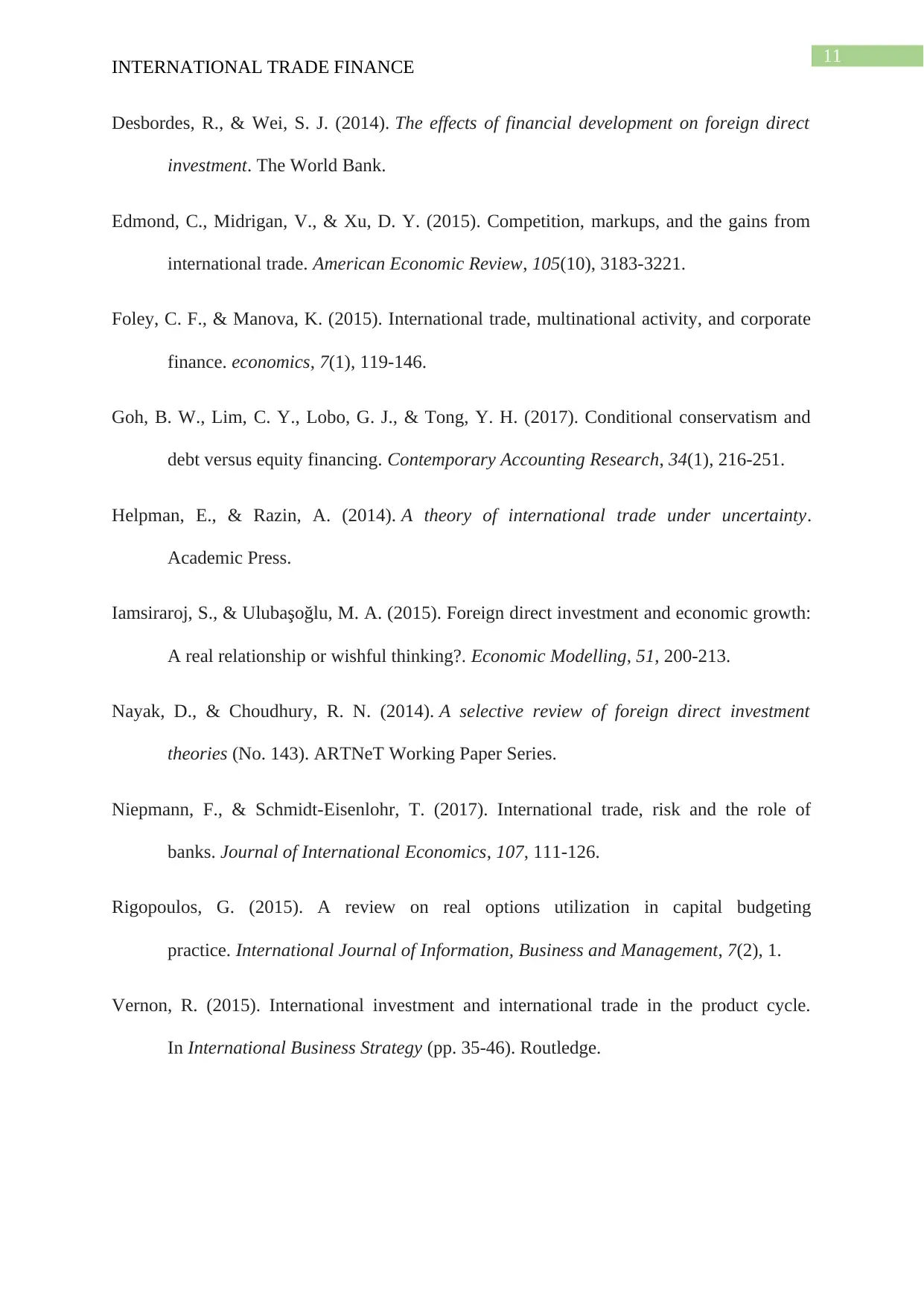
11
INTERNATIONAL TRADE FINANCE
Desbordes, R., & Wei, S. J. (2014). The effects of financial development on foreign direct
investment. The World Bank.
Edmond, C., Midrigan, V., & Xu, D. Y. (2015). Competition, markups, and the gains from
international trade. American Economic Review, 105(10), 3183-3221.
Foley, C. F., & Manova, K. (2015). International trade, multinational activity, and corporate
finance. economics, 7(1), 119-146.
Goh, B. W., Lim, C. Y., Lobo, G. J., & Tong, Y. H. (2017). Conditional conservatism and
debt versus equity financing. Contemporary Accounting Research, 34(1), 216-251.
Helpman, E., & Razin, A. (2014). A theory of international trade under uncertainty.
Academic Press.
Iamsiraroj, S., & Ulubaşoğlu, M. A. (2015). Foreign direct investment and economic growth:
A real relationship or wishful thinking?. Economic Modelling, 51, 200-213.
Nayak, D., & Choudhury, R. N. (2014). A selective review of foreign direct investment
theories (No. 143). ARTNeT Working Paper Series.
Niepmann, F., & Schmidt-Eisenlohr, T. (2017). International trade, risk and the role of
banks. Journal of International Economics, 107, 111-126.
Rigopoulos, G. (2015). A review on real options utilization in capital budgeting
practice. International Journal of Information, Business and Management, 7(2), 1.
Vernon, R. (2015). International investment and international trade in the product cycle.
In International Business Strategy (pp. 35-46). Routledge.
INTERNATIONAL TRADE FINANCE
Desbordes, R., & Wei, S. J. (2014). The effects of financial development on foreign direct
investment. The World Bank.
Edmond, C., Midrigan, V., & Xu, D. Y. (2015). Competition, markups, and the gains from
international trade. American Economic Review, 105(10), 3183-3221.
Foley, C. F., & Manova, K. (2015). International trade, multinational activity, and corporate
finance. economics, 7(1), 119-146.
Goh, B. W., Lim, C. Y., Lobo, G. J., & Tong, Y. H. (2017). Conditional conservatism and
debt versus equity financing. Contemporary Accounting Research, 34(1), 216-251.
Helpman, E., & Razin, A. (2014). A theory of international trade under uncertainty.
Academic Press.
Iamsiraroj, S., & Ulubaşoğlu, M. A. (2015). Foreign direct investment and economic growth:
A real relationship or wishful thinking?. Economic Modelling, 51, 200-213.
Nayak, D., & Choudhury, R. N. (2014). A selective review of foreign direct investment
theories (No. 143). ARTNeT Working Paper Series.
Niepmann, F., & Schmidt-Eisenlohr, T. (2017). International trade, risk and the role of
banks. Journal of International Economics, 107, 111-126.
Rigopoulos, G. (2015). A review on real options utilization in capital budgeting
practice. International Journal of Information, Business and Management, 7(2), 1.
Vernon, R. (2015). International investment and international trade in the product cycle.
In International Business Strategy (pp. 35-46). Routledge.
⊘ This is a preview!⊘
Do you want full access?
Subscribe today to unlock all pages.

Trusted by 1+ million students worldwide
1 out of 12
Related Documents
Your All-in-One AI-Powered Toolkit for Academic Success.
+13062052269
info@desklib.com
Available 24*7 on WhatsApp / Email
![[object Object]](/_next/static/media/star-bottom.7253800d.svg)
Unlock your academic potential
Copyright © 2020–2025 A2Z Services. All Rights Reserved. Developed and managed by ZUCOL.




